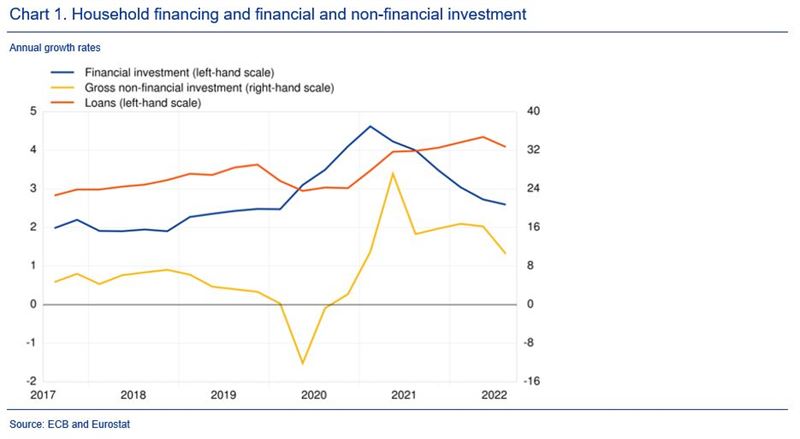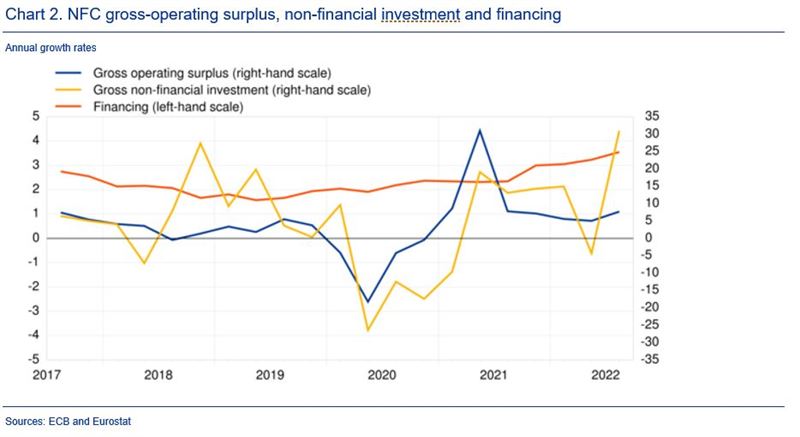- Households’ financial investment increased at slightly lower annual rate of 2.6% in third quarter of 2022, after 2.7% in second quarter
- Non-financial corporations’ financing increased at higher rate of 3.6%, after 3.2%
- Non-financial corporations’ gross operating surplus increased at higher rate of 7.6%, after 5.0%

Data for household financing and financial and non-financial investment

Data for NFC gross-operating surplus, non-financial investment and financing
Households
Household gross disposable income increased at an annual rate of 6.9% in the third quarter of 2022 (after 5.9% in the previous quarter). Compensation of employees grew at a lower rate of 5.9% (after 7.7%), while gross operating surplus and mixed income of the self-employed increased at a broadly unchanged rate of 5.8%. Household consumption expenditure grew at a lower rate of 9.6% (after 12.8%).
The household gross saving rate (calculated from four-quarter sums) was 14.2% in the third quarter of 2022, compared with 14.8% in the previous quarter.
Household gross non-financial investment (which refers mainly to housing) increased at an annual rate of 10.6% in the third quarter of 2022, down from 16.2% in the previous quarter. Loans to households, the main component of household financing, increased at a lower rate of 4.1% (after 4.3%), while other liabilities1 grew at a higher rate of 15.3% (after 14.3%).
Household financial investment increased at a slightly lower annual rate of 2.6% in the third quarter of 2022, after 2.7% in the previous quarter. Among its components, currency and deposits grew at a higher annual rate of 4.1% (after 3.8%). Investment in life insurance and pension schemes grew at a lower rate of 1.5% (after 1.8%) and shares and other equity grew at a lower rate of 1.7% (after 2.4%). Investment in debt securities increased at an annual rate of 6.6%, compared to -0.5% in the previous quarter.
Household net worth grew at an annual rate of 2.0% in the third quarter of 2022, after 3.5% in the previous quarter. The growth of net worth was predominantly due to valuation gains in non-financial assets, followed by financial and non-financial investment. The deceleration of growth was mainly driven by higher valuation losses in financial assets. Housing wealth, the main component of non-financial assets, grew at a lower rate of 7.6% (after 8.7%). The household debt-to-income ratio decreased to 94.6% in the third quarter of 2022 from 96.0% in the third quarter of 2021.
Non-financial corporations
Net value added by NFCs increased at an annual rate of growth of 8.2% in the third quarter of 2022, after 10.3% in the previous quarter. Gross operating surplus increased at a higher rate of 7.6%, after 5.0% in the previous quarter, while net property income (defined in this context as property income receivable minus interest and rent payable) increased at a lower rate (18.9% after 19.2%). As a result gross entrepreneurial income (broadly equivalent to cash flow) increased at a higher rate of 8.4% (after 7.4%).2
NFCs’ gross non-financial investment increased at an annual rate of 30.9%, mainly due to an increase in gross fixed capital formation, which includes a large acquisition of intellectual property products, compared to a decrease in the previous quarter (-4.3%) which was due to large net disposals of non-produced assets.3 NFCs’ financial investment increased at an unchanged rate of 4.8%. Compared with the previous quarter, loans granted as well as currency and deposits grew at lower rates of 6.2% (after 6.6%) and 7.0% (after 7.9%) respectively, while net purchases of shares and other equity grew at a higher rate of 3.1% (after 2.4%).
Financing of NFCs increased at a higher annual rate of 3.6% (after 3.2%), reflecting higher growth rates of financing via loans (6.3% after 5.5%)4 and equity (1.6% after 1.2%), while financing via debt securities (3.3% % after 4.9%) and trade credits (9.5% after 11.6%) decelerated.
NFCs’ debt-to-GDP ratio (consolidated measure) decreased to 77.7% in the third quarter of 2022, from 79.4% in the same quarter of the previous year; the non-consolidated, wider debt measure decreased to 140.2% from 142.5%.
ecb.europa.eu

















